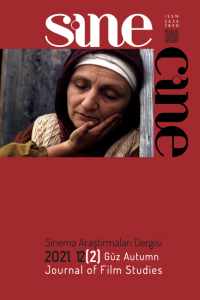YIKIM FİLMLERİ: KENDİ HİKÂYELERİNİN KIYISINDA GECEKONDULULAR
Bu makale, 1970’lerin sonlarına doğru gecekondu problemine giderek artan bir ilgi gösteren popüler sinemanın, buralarda oturan yoksul halkın kültürel temsili meselesi ile nasıl başa çıkmaya çalıştığını inceler. Popüler filmler –özellikle de yıkım sorunu ile ilgilenenler– bu gruba bir pozitif kimlik ve eylemlilik kapasitesi atfetmekten kaçınmıştır. Gecekondu problemi hikâyenin odağında olsa bile, filmler gecekonduluları ağırlıklı olarak anlatının çeperinde konumlamıştır. Onlar ekranın kenarlarında, içeri dalıp kendi hikâyelerinin baş aktörü olmaktan aciz, bulanık bir kalabalık olarak dururlar. Bu çalışmada, 1970’ler Türkiye’sinde şehirli yoksulların pragmatik veya ideoloji taşımayan (dolayısıyla muğlak, olgunlaşmamış ve güvenilmez) bir grup olduklarını yayan imajın, en azından kısmen, kültürel elitlerin tamamının katkısıyla inşa edilmiş bir kimlik olduğunu iddia ediyorum. Başka meselelerde birbirlerine düşman ideolojik pozisyonlar arasında bile böylesi bir kimliği oluşturmak ve desteklemek konusunda görülen bu şaşırtıcı uyum, geleneksel toplumsal kategorilerin dışında veya arasında bir yere düşen bu yeni sosyal formasyonun kültürel üretim alanındaki bütün yerleşik çerçeveler açısından sembolik bir zorluk yaratmasına karşı geliştirilen ortak bir tepki olarak açıklanabilir.
Anahtar Kelimeler:
Şehirli yoksullar, kültürel temsil, kimlik, gecekondu
DEMOLITION MOVIES: THE URBAN POOR ON THE MARGINS OF THEIR STORY
This article analyzes how the popular cinema in Turkey, which showed a heightened interest in the gecekondu (slum or squatter house) problem in the late 1970s, tackled the question of representing the poor residents of these areas. The popular films – particularly the ones about the problem of demolition– denied a positive identity and agency to this group. The films positioned the squatters predominantly on the periphery of the narrative, although the gecekondu problem was at the center of the story. They appeared as a blurry crowd lurking behind or on the edges of the screen, unable to step in and be the leading actors of their own story. I argue that in the context of 1970s Turkey, the stereotypical image of the urban poor as a pragmatic or non-ideological (thus ambivalent, immature and unreliable) group was, at least in part, a constructed identity in which all the cultural elite contributed. This surprising collaboration between otherwise hostile ideological positions in constructing and reinforcing such an identity can be seen as a common reaction to the symbolic challenge that the squatters, as a new social formation falling outside or between traditional social categories, posed to all established frameworks of cultural production.
Keywords:
Urban poor, cultural representation, identity, gecekondu,
___
- Avcı, Ö. (2011). The Gecekondulu in Turkey: Representation, Identity, and the Urban Poor in the 1960s and 1970s. (Unpublished PhD Dissertation). Milwaukee: The University of Wisconsin.
- Erdoğan, N. (2002). Garibanların Dünyası: Türkiye'de Yoksulların Kültürel Temsilleri Üzerine İlk Notlar. N. Erdoğan (Ed.) Yoksulluk Hâlleri: Türkiye'de Kent Yoksulluğunun Toplumsal Görünümleri (pp. 21-32). İstanbul: Demokrasi.
- Kahraman, H. B. (2002). Yitirilmemiş Zamanın Ardında: Ahmet Hamdi Tanpınar ve Muhafazakâr Modernliğin Estetik Düzlemi. A. Uçman (Ed.) Bir Gül Bu Karanlıklarda: Tanpınar Üzerine Yazılar (pp. 612-645). İstanbul: Kitabevi.
- Karakayalı, N. (2001). An Introduction to the History of Music Debates in Turkey. A. Hammerlund (Ed.), Sufism, Music and Society (pp. 125-136). İstanbul: Curzon.
- Landy, M. (1991). Introduction. M. Landy (Ed.) Imitations of Life: A Reader on Film & Television Melodrama (pp. 13-30). Detroit, MI: Wayne State University.
- McGowan, T. (2007). The Real Gaze: Film Theory After Lacan. Albany, NY: State University of New York.
- Öztürk, M. (2004). Türk Sinemasında Gecekondular. European Journal of Turkish Studies, 1, http://ejts.revues.org/index94.html.
- Rimmon-Kenan, S. (1989). Narrative Fiction: Contemporary Poetics. NY: Routledge.
- Scognamillo, G. (1998). Türk Sinema Tarihi. İstanbul: Kabalcı.
- Sennett, R. & Cobb, J. (1993). The Hidden Injuries of Class. USA: W.W. Norton & Company.
- Smith, J. L. (1973). Melodrama. London: Methuen & Co.
- Steele, W. P. (1968). The Character of Melodrama. Maine: University of Maine.
- Yıldız, E. (2008). Gecekondu Sineması. İstanbul: Hayalet.
- ISSN: 2636-784X
- Yayın Aralığı: Yıllık
- Başlangıç: 2010
- Yayıncı: Semire Ruken Öztürk
Sayıdaki Diğer Makaleler
MULTİPLEKS SİNEMA SALONLARI VE TÜRKİYE ÖRNEĞİNDE SİNEMA SEKTÖRÜNDE DEĞİŞEN GÜÇ DENGELERİ
Demolition movies: The urban poor on the margins of their story
Çağdaş Fransız kadın sineması (var mıdır?)
YERALTI’NI NIETZSCHE’DEN OKUMAK
SİNEMA ARAŞTIRMALARININ ÖZÜ VE GELİŞİMİ
SİNEMADA SOSYAL ETKİLEŞİM ARAYIŞLARI
YIKIM FİLMLERİ: KENDİ HİKÂYELERİNİN KIYISINDA GECEKONDULULAR
Filmozofi: Sinemayı Yepyeni Tarzda Anlamak İçin Bir Manifesto
